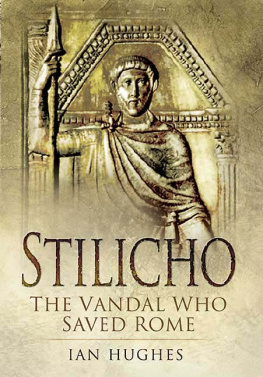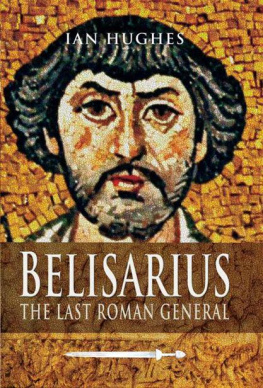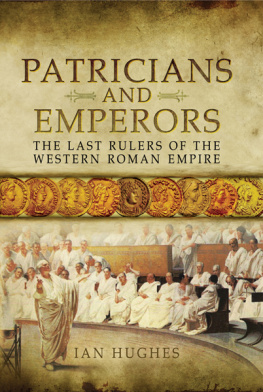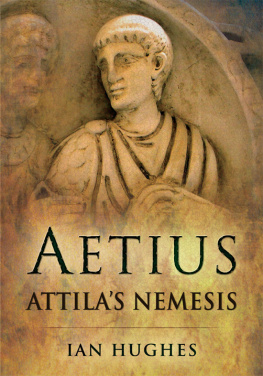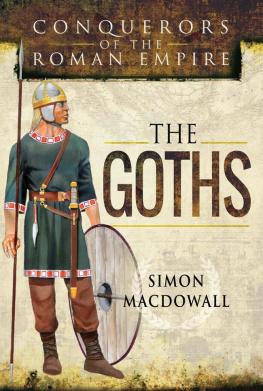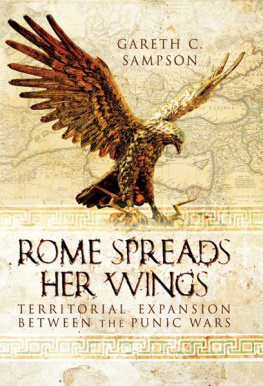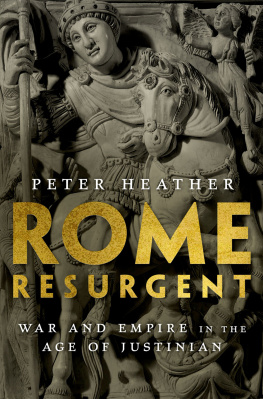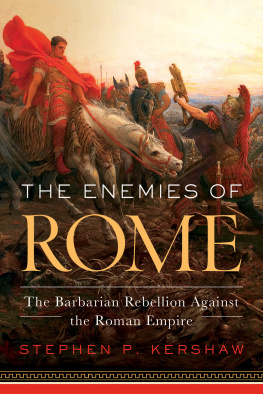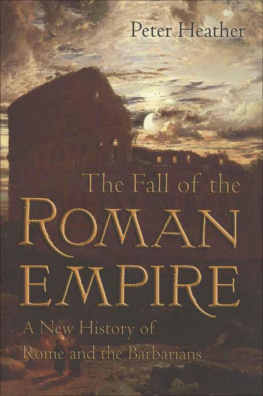
Gaiseric
Gaiseric
The Vandal Who Destroyed Rome
Ian Hughes
First published in Great Britain in 2017 by
Pen & Sword Military
an imprint of
Pen & Sword Books Ltd
47 Church Street
Barnsley
South Yorkshire
S70 2AS
Copyright Ian Hughes, 2017
ISBN 978 1 78159 018 8
eISBN 978 1 47389 029 9
Mobi ISBN 978 1 47389 028 2
The right of Ian Hughes to be identified as Author of this work has been asserted by him in accordance with the Copyright, Designs and Patents Act 1988.
A CIP catalogue record for this book is available from the British Library.
All rights reserved. No part of this book may be reproduced or transmitted in any form or by any means, electronic or mechanical including photocopying, recording or by any information storage and retrieval system, without permission from the Publisher in writing.
Pen & Sword Books Ltd incorporates the Imprints of Pen & Sword Archaeology, Atlas, Aviation, Battleground, Discovery, Family History, History, Maritime, Military, Naval, Politics, Railways, Select, Transport, True Crime, Fiction, Frontline Books, Leo Cooper, Praetorian Press, Seaforth Publishing, Wharncliffe and White Owl.
For a complete list of Pen & Sword titles please contact
PEN & SWORD BOOKS LIMITED
47 Church Street, Barnsley, South Yorkshire, S70 2AS, England
E-mail:
Website: www.pen-and-sword.co.uk
List of Maps
Map 1: The Roman Empire on the Death of Theodosius, AD 395
Map 2: The Invasion of Gaul
Map 3: Gaul and Hispania
Map 4: Hispania: the placement of the settlements is approximate
Map 5: The Move to Baetica and Later Expansion
Map 6: Heremigarius and the Emigration
Map 7: The Vandals Cross to Africa
Map 8: The Vandal Settlement of 435
Map 9: The Romano-Vandal War and the Settlement of 442
Map 10: The Romano-Vandal War
Map 11: Majorians African Campaign
Map 12: The Vandals at War
Map 13: The Roman Invasion of 468
Map 14: Gaiserics Last Campaigns
Introduction
What ruined everything was the action of the Vandals in crossing from Spain to Africa the Vandal chief Gaiseric was not only a man of genius but one of the most fateful figures in history, for it was he who really brought about the downfall of the Western Empire.
Saunders, J.J., The Debate on the Fall of Rome(1963), p.15
A sk a member of the general public to name the individuals or tribes involved in the fall of the (Western) Roman Empire, and the chances are that the questioner will receive blank stares in response. The more knowledgeable will answer with Attila the Hun, at which point even the most uninterested will acknowledge that they have, indeed, heard of Attila. Yet Attilas part in the downfall of the Western Empire was, in reality, minor. He led an invasion of Gaul in AD 451 and Italy in 452, before he died of a haemorrhage in 453. As this was almost a quarter of a century before the accepted date of 476 for the death of the last Roman emperor, it would seem that he actually played only a supporting role in the collapse of the West. Very few will know the name of Gaiseric.
Interestingly, the names of the three major tribes have been distorted over the intervening centuries: Hun is a nickname given in Europe and North America to modern Germans, Gothic is a style of architecture and Vandal is the name given to any form of wanton destruction.
Yet, as demonstrated in the quote at the beginning of this Introduction, the actions of Gaiseric, King of the Vandals, is acknowledged by all students of the period as having a major impact upon the Fall. There is little question that Gaiseric was the most important Vandal king and was among the most influential figures of the fifth-century Mediterranean world.
Yet strangely, his name has fallen out of use, and memory of his actions is limited to a small group of specialists who concern themselves with the question of why the Western Empire fell. The reason for his fall from grace is easy to understand. The main cause is that for many historians of the past centuries, the main focus has been on the actions of the Roman Empire rather than on their enemies. In addition, the sources for any of the barbarian kings are limited and hard to reconcile, so their histories remained largely unwritten.
A second factor is that Gaiseric did not have a demonic label attached to him. Being pagan, the Huns did not acknowledge the sanctity of Christian churches. In addition, they are described by contemporary sources as being hardly human, and in Attila they had a leader who earned the epithet Scourge of God. Of even more importance, when the Huns invaded Italy in 452, Christian tradition ascribed his sparing of Rome to Pope Leo I, aided by divine intervention. The miraculous saving of Rome resulted in the name of Attila being preserved in Christian tradition.
If the Huns were the epitome of all that was evil, the Goths had the advantage of founding a long-lasting kingdom in Hispania and of converting to Catholic Christianity. Their conversion from the heretical Arianism practised by most of the Germanic nations resulted in their entry into the accepted tribes of Christendom. Furthermore, they produced a historian named Jordanes, who wrote A History of the Goths , preserving information concerning the Gothic verbal histories. The outcome was that the Goths became simply one more of the kingdoms that arose on the ruins of the West, and the fact that they were accepted resulted in Gothic becoming simply an architectural style. Possibly because of their acceptance, their leaders are unknown largely due to them not having the label demon, as given to Attila.
The Vandals, on the other hand, were simply outcasts as far as contemporary writers were concerned. Although their King Gaiseric was a major figure throughout the majority of the fifth century, the fact that he remained staunchly Arian resulted in him being anathema to contemporary Romans, albeit obviously not as horrific as the pagan Attila. The fact that the Vandal kingdom in Africa only lasted for 111 years may also have been a factor in the fact that no Vandal historian comparable to Jordanes wrote a history of the Vandals. Without a favourable historian, and with a leader who failed to match Attila for detestation, it is necessary to rely on scanty Roman sources to piece together the story of the Vandals most effective leader.
In this context, it should be noted that almost all of the information concerning the Vandals, and especially that with regard to religion, is filtered through the works of Nicene (Catholic) clergymen and anti-Vandal authors who had reason to depict them as the enemy of Catholicism. For example, Victor of Vita was probably writing during the persecution of Catholics declared by Huneric just before the latters death in December 484. As a consequence, it is understandable that Victors rhetoric is violently anti-Vandal, and his lurid descriptions of the sufferings of the Catholics are augmented by his depth of feelings against the Vandals. Yet Victors need to vilify the Vandals means that his work must be used with care, as there is a real possibility that he has exaggerated Vandal actions in order to make them fit into his anti-Vandal rhetoric.
Victor isnt the only ancient writer who was interested in Gaiseric. Gaiseric receives far and away the most attention from Prosper, both because Prosper was probably in or around Rome when it was sacked by the Vandals in 455, and Gaiseric was the only barbarian leader to actively seek to replace Nicene Christianity with the Arian impiety.
Next page

